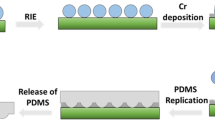Abstract
This article exposes the beginnings of a new field which could be named as “plasmomechanics”. Plasmomechanics comes from the convergence between mechanics and plasmonics. Here we discuss a relatively recent topic whose technological aim is the development of plasmonic strain sensors. The idea is based on the ability to deduce Au nanoparticles (NPs) distance distributions from polarized optical extinction spectroscopy which could thus give access to material strains. Variations of interparticle distances distributions can indeed lead to variations of plasmonic coupling and thus to material color change as shown here experimentally and numerically for random Au NP assemblies deposited onto elastomer films.
Similar content being viewed by others
References
Haes A J, Van Duyne R P. A nanoscale optical biosensor: sensitivity and selectivity of an approach based on the localized surface plasmon resonance spectroscopy of triangular silver nanoparticles. Journal of the American Chemical Society, 2002, 124(35): 10596–10604
Homola J, Yee S S, Gauglitz G. Surface plasmon resonance sensors. Sensors and Actuators B: Chemical, 1999, 54(1–2): 3–15
Liao H, Nehl C L, Hafner J H. Biomedical applications of plasmon resonant metal nanoparticles. Nanomedicine, 2006, 1(2): 201–208
Haes A J, Chang L, Klein W L, et al. Detection of a biomarker for Alzheimer’s disease from synthetic and clinical samples using a nanoscale optical biosensor. Journal of the American Chemical Society, 2005, 127(7): 2264–2271
Daniel M C, Astruc D. Gold nanoparticles: assembly, supramolecular chemistry, quantum-size-related properties, and applications toward biology, catalysis, and nanotechnology. Chemical Reviews, 2004, 104(1): 293–346
Haruta M. Gold as a novel catalyst in the 21st century: Preparation, working mechanism and applications. Gold Bulletin, 2004, 37(1–2): 27–36
Sazonova V, Yaish Y, Ustünel H, et al. A tunable carbon nanotube electromechanical oscillator. Nature, 2004, 431(7006): 284–287
van der Zande A M, Barton R A, Alden J S, et al. Large-scale arrays of single-layer graphene resonators. Nano Letters, 2010, 10(12): 4869–4873
Gloppe A, Verlot P, Dupont-Ferrier E, et al. Bidimensional nano-optomechanics and topological backaction in a non-conservative radiation force field. Nature Nanotechnology, 2014, 9(11): 920–926
Clair A, Foucault M, Calonne O, et al. Strain mapping near a triple junction in strained Ni-based alloy using EBSD and biaxial nanogauges. Acta Materialia, 2011, 59(8): 3116–3123
Marae-Djouda J, et al. Nanogauges gratings for strain mapping at the nanoscale. (submitted)
Correa-Duarte M A, Salgueiriño-Maceira V, Rinaldi A, et al. Optical strain detectors based on gold/elastomer nanoparticulated films. Gold Bulletin, 2007, 40(1): 6–14
Jain P K, Huang W, El-Sayed M A. On the universal scaling behavior of the distance decay of plasmon coupling in metal nanoparticle pairs: a plasmon ruler equation. Nano Letters, 2007, 7(7): 2080–2088
Tabor C, Murali R, Mahmoud M, et al. On the use of plasmonic nanoparticle pairs as a plasmon ruler: the dependence of the near-field dipole plasmon coupling on nanoparticle size and shape. The Journal of Physical Chemistry A, 2009, 113(10): 1946–1953
Maurer T, et al. Strategies for self-organization of Au nanoparticles assisted by copolymer templates. In: Plasmonics: Metallic Nanostructures and Their Optical Properties XI. Proceedings of the SPIE Society, San Diego, 2013
Lamarre S S, Sarrazin A, Proust J, et al. Optical properties of Au colloids self-organized into rings via copolymer templates. Journal of Nanoparticle Research, 2013, 15(5): 1656
Sarrazin A, Gontier A, Plaud A, et al. Single step synthesis and organization of gold colloids assisted by copolymer templates. Nanotechnology, 2014, 25(22): 225603
Jiang C, Markutsya S, Tsukruk V V. Collective and individual plasmon resonances in nanoparticle films obtained by spinassisted layer-by-layer assembly. Langmuir, 2004, 20(3): 882–890
Cataldi U, Caputo R, Kurylyak Y, et al. Growing gold nanoparticles on a flexible substrate to enable simple mechanical control of their plasmonic coupling. Journal of Materials Chemistry C, 2014, 2(37): 7927–7933
Romero I, Aizpurua J, Bryant G W, et al. Plasmons in nearly touching metallic nanoparticles: singular response in the limit of touching dimers. Optics Express, 2006, 14(21): 9988–9999
Xu Y L. Electromagnetic scattering by an aggregate of spheres: far field. Applied Optics, 1997, 36(36): 9496–9508
Author information
Authors and Affiliations
Corresponding author
Rights and permissions
About this article
Cite this article
Maurer, T., Marae-Djouda, J., Cataldi, U. et al. The beginnings of plasmomechanics: towards plasmonic strain sensors. Front. Mater. Sci. 9, 170–177 (2015). https://doi.org/10.1007/s11706-015-0290-z
Received:
Accepted:
Published:
Issue Date:
DOI: https://doi.org/10.1007/s11706-015-0290-z




